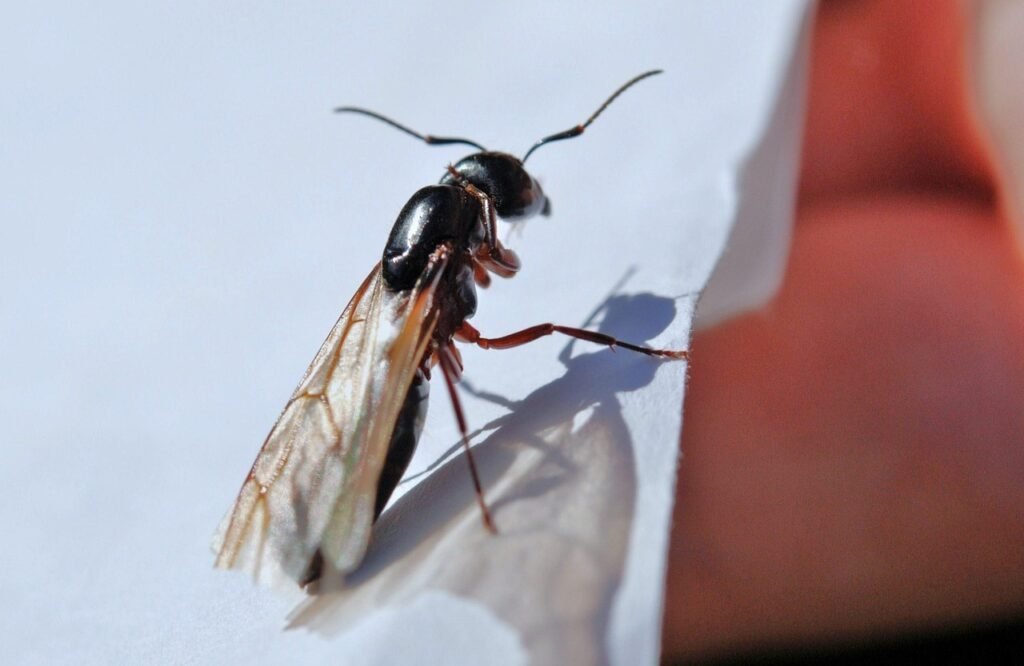Every summer, people across the UK witness a sudden surge of winged ants filling the air, crawling over pavements, and sometimes even showing up on weather radar. This phenomenon, popularly known as “Flying Ant Day,” is when thousands—sometimes millions—of ants emerge from their nests almost simultaneously to take to the skies. Despite the name, it rarely happens on a single day. Instead, swarms can appear over several days or even weeks, depending on the weather and region.
Why Do Flying Ants Swarm?
The spectacle is part of the ants’ natural life cycle, known as the “nuptial flight.” During this period, new queens and male ants grow wings and leave their colonies in search of mates. Mating takes place mid-air, after which the fertilised queens drop to the ground, shed their wings, and begin the process of starting new colonies. The males, having fulfilled their role, die shortly after.
This mass emergence is a strategy that increases the chances of successful mating and helps avoid predators. By synchronising their flights, ants ensure that enough individuals survive to establish the next generation of colonies.
When Does Flying Ant Day Happen
There is no fixed date for Flying Ant Day. The event typically occurs during the warm, humid months of July and August, but sightings have been recorded as early as June and as late as September, depending on local weather conditions. The Royal Society of Biology and other experts confirm that the timing varies widely across the country, with different areas experiencing their own “flying ant days” at different times.
In 2025, experts predict the peak will likely fall between 22 and 25 July, although swarms could begin earlier if warm, humid weather arrives sooner than expected. Urban areas such as London often see earlier activity due to the “heat island” effect, where city temperatures accelerate ant development and emergence.
Triggers the Swarm
Flying ants wait for just the right conditions before taking flight. Warmth, high humidity, and low wind speeds are essential. These factors make it easier for ants to fly and mate successfully. Heavy rain or strong winds can delay or disrupt the event, while a run of hot, calm days can bring swarms out in force.
In some years, swarms have been so large that weather radar has mistaken them for rain clouds, with mile-wide clouds of ants detected over the south coast and southeast England. The Met Office regularly receives reports of these swarms, which can appear as sudden, dense “showers” on radar images.
Are Flying Ants Dangerous?
For most people, flying ants are more of a nuisance than a threat. They do not sting or bite unless provoked, and their presence is short-lived. However, large swarms can be overwhelming, especially in urban areas. Some residents have reported difficulty leaving their homes or cars when swarms are particularly dense.
Despite the inconvenience, flying ants play a crucial ecological role. After mating, the new queens burrow into the soil, helping to aerate it. The ants themselves are also a valuable food source for birds, especially gulls and starlings, which can often be seen swooping through swarms for a feast.
Myths and Science: Is There Really Just One Flying Ant Day
The idea of a single, nationwide Flying Ant Day is a myth. Research by the Royal Society of Biology and University of Gloucestershire shows that flying ants can emerge on almost any warm, calm day between June and September. While there are often a few days when swarming is especially intense, the event is staggered across regions and even between neighbouring gardens.
Professor Adam Hart, an entomologist involved in the UK’s largest flying ant survey, explains that ants are guided by local weather rather than a national schedule. This means that while one street might be swarming with ants, another just a mile away could see no activity at all.
What Should You Do If You Encounter a Swarm?
Experts recommend keeping windows and doors closed during peak swarming times to prevent ants from entering your home. Storing food securely and using fly screens can help minimise indoor infestations. If you find yourself caught in a swarm outdoors, simply brushing the ants off and moving away from the area is usually enough.
For those interested in nature, Flying Ant Day is a fascinating opportunity to observe one of the UK’s most impressive natural spectacles. Citizen science projects, such as the Royal Society of Biology’s Flying Ant Survey, encourage the public to report sightings and help scientists track the phenomenon across the country.
Conclusion
Flying Ant Day is more than just a summer oddity. It is a vital part of the ant life cycle and an important ecological event for the UK. The mass emergence of flying ants supports biodiversity, helps maintain healthy soils, and provides food for wildlife. While the swarms can be startling, they are a sign of a healthy, functioning ecosystem.
As the UK heads into another summer, experts are urging the public to be prepared for what could be one of the largest swarming events in recent years, thanks to a combination of high humidity and fluctuating temperatures. Whether you find them fascinating or frustrating, Flying Ant Day is a reminder of the remarkable natural events that unfold just outside our doors.
To read more click here

